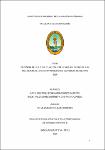Potencia de luz y su relación con estado de filtro de luz en lámparas led de fotocurado en la ciudad de Iquitos, 2019

View/
Date
2019Author
Reátegui Echevarria, Renzo Alberto
Valladares Murrieta, Cristhian Alfredo
Metadata
Show full item recordAbstract
El objetivo de nuestro estudio fue determinar si existen diferencias entre la potencia de luz en una lámpara led con el filtro contaminado y una lámpara led con el filtro no contaminado utilizado en consultorios de la ciudad de Iquitos en el año 2019. La muestra estuvo conformada por 153 lámparas led, el estudio fue cuantitativo, descriptivo corte transversal correlacional y se obtuvo los siguientes resultados:
La marca más utilizada fue la Woodpecker con el 60.8%. (93), seguido de otras marcas con el 33.3% (51), las marcas Ivoclar, 3M y Gnatus solo fueron el 2% de la muestra (3 cada uno). En relación al tiempo de uso al momento del estudio el 35.9% (55) estaban siendo utilizados más de tres años, el 19% (29) 2 años, el 15.7% (24) menos de 6 meses, el 13.1% (20) más de 2 años, 8.5%% (13) 1 año, el 5.9% (09) más de 1 año y el 2% (03) más de 6 meses. En cuanto a la frecuencia de uso de las lámparas led al momento de obtener los resultados, el 28.8% (44) fueron utilizados diariamente, el 28.1% (43) fueron utilizados semanalmente, el 17% (26) se utilizó quincenalmente, , el 12.4% (19) se utilizó mensualmente , 11.8% (18) se usó interdiariamente y el 2% (3) trimestralmente. Se determinó que las lámparas led fueron utilizadas con los siguientes tiempos de fotocurado: el 78.4% (120) 20 segundos, el 7.2% (11) 40 segundos, el 4.6% (07) 5 segundos, el 3.9% (06) 30 segundos, el 2.6% (04) 10 segundos, el 2% (03) 15 segundos y el 1.3 (02) 25 segundos. El 94.1% (144) tiene una longitud de filtro de 5 cm., el 5.2% (08) otras longitudes y el 0.7% (01) 10 cm. El 42.5% (65) de las lámparas led pertenecen al sector privado, el 57.5% (88) al sector estatal. El 49% (75) de las lámparas led fueron limpiados antes de su uso y el 51% (78) no se limpió antes de su uso. El 94.7% (71) de las lámparas limpiadas antes de su uso utilizaron alcohol y el 5.3% (04) otro tipo de solvente. El 91.5% (140) no utilizó barrera de protección para su uso y el 8.5% (13) si utilizó barrera de protección antes de su uso. Se pudo determinar que el 90.8% (139) de lámparas led con filtro contaminado tienen una potencia recomendada (>400 mw/cm2) y el 9.2% (14) no tiene la potencia recomendada (<400 mw/cm2), además se determinó que el 91.5% (140) de lámparas led con filtro no contaminado tienen una potencia recomendada (>400 mw/cm2) y el 8.5% (13) no tiene una potencia recomendada (<400 mw/cm2) por lo tanto se pudo determinar que si existe relación entre la potencia de luz de las lámparas led con filtro contaminado y no contaminado , obteniendo un valor de p= 0,0000 (p > 0.05). The objective of our study was to determine if there are differences between the light power in a led lamp with the contaminated filter and a led lamp with the non-contaminated filter used in offices in the city of Iquitos in 2019. The sample consisted of 153 led lamps, the study was quantitative, correlational descriptive cross section and the following results were obtained: The most used brand was the Woodpecker with 60.8%. (93), followed by other brands with 33.3% (51), the Ivoclar, 3M and Gnatus brands were only 2% of the sample (3 each). In relation to the time of use at the time of the study, 35.9% (55) were being used more than three years, 19% (29) 2 years, 15.7% (24) less than 6 months, 13.1% (20) more than 2 years, 8.5 %% (13) 1 year, 5.9% (09) more than 1 year and 2% (03) more than 6 months. Regarding the frequency of use of led lamps at the time of obtaining the results, 28.8% (44) were used daily, 28.1% (43) were used weekly, 17% (26) was used biweekly,, the 12.4% (19) was used monthly, 11.8% (18) was used interdiarily and 2% (3) quarterly. It was determined that the LED lamps were used with the following light curing times: 78.4% (120) 20 seconds, 7.2% (11) 40 seconds, 4.6% (07) 5 seconds, 3.9% (06) 30 seconds , 2.6% (04) 10 seconds, 2% (03) 15 seconds and 1.3 (02) 25 seconds. 94.1% (144) has a filter length of 5 cm, 5.2% (08) other lengths and 0.7% (01) 10 cm. 42.5% (65) of LED lamps belong to the private sector, 57.5% (88) to the state sector. 49% (75) of the led lamps were cleaned before use and 51% (78) was not cleaned before use. 94.7% (71) of the lamps cleaned before use used alcohol and 5.3% (04) another type of solvent. 91.5% (140) did not use protection barrier for its use and 8.5% (13) did use protection barrier before use. It was determined that 90.8% (139) of LED lamps with a contaminated filter have a recommended power (> 400 mw / cm2) and 9.2% (14) do not have the recommended power (<400 mw / cm2), it was also determined that 91.5% (140) of LED lamps with a non-contaminated filter have a recommended power (> 400 mw / cm2) and 8.5% (13) does not have a recommended power (<400 mw / cm2), therefore it could be determined if there is a relationship between the light power of the LED lamps with a contaminated and uncontaminated filter, obtaining a value of p = 0.0000 (p> 0.05).
Collections
- Tesis [171]
The following license files are associated with this item:

